WE’RE BACK AND BIGGER THAN EVER!
After a short hiatus and a bit of restructuring, the
warrior-scribes are back in action here at ye olde CHUD.com-e. Expect to see a
regular column every Sunday or Monday night with a renewed focus on trade and
collected material, which seems to be how the bulk of the CHUD readership gets
their four-color fix.
For those of you who still read monthly comics and enjoy
the occassional small press or indie book, be sure to check out the
warrior-scribes’ expanded comic book review site RACK RAIDS at www.rackraids.com.
Happy Holidays!
Elgin Carver: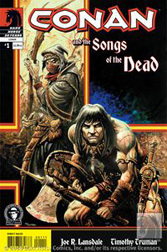 Conan and the Songs of
Conan and the Songs of
the Dead # 1 – 4
If you are even vaguely male you enjoy Conan and his adventures. Powerful,
irresistible to women, able to protect himself in any circumstances, ultimately
successful in anything he attempts, virtually unafraid, a man among men. In the
tales by Robert E. Howard these attributes are told in a manner that makes even
the most disturbing circumstances seem attractive, even desirable. These are stories
one cannot stop reading no matter how repulsive the monster faced. Here is the
hero one dreams of being no matter how vicious and repellant his actions. This
is the art of a master storyteller.
It is easy to confuse the ability to competently tell a story with the elements
of adventure, with the ability of a master to tell an adventure story. This
comic series is the former. It is interesting. It is not enthralling. The
Howard stories are violent, even graphic, but written in a manner that allows
the reader to envy the protagonist without dwelling on the gore. These books
revel in the gore without giving an adequate reason to admire the hero. The original
books could hint at the sexual implications of artifacts and actions that
titillated and excited without descending into the tawdry nature that such
items and events would of necessity demonstrate in reality. In this series they
are very Monty Python. Wink. Wink. Nudge. Nudge.
This is not a bad story. Issue number 4 leaves you wanting to read issue number
5, and on that level they are a success. The artwork is competent if
uninspired. It is not Robert E. Howard good. But then what is?

THREE OUT OF FIVE VIKINGS
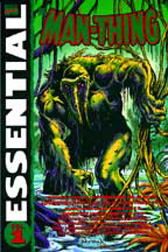
Essential Man-Thing Volume 1
The most obvious case of industrial espionage in comics history is the publication
of the Man-Thing 30 days before the appearance of Swamp Thing. Who spied on
whom? Not even comic historians seem stimulated enough by the question to
investigate. This leaves only the contents of the books as the "interesting"
subject .
The Swamp Thing is a shambling pile of ooze that once was a man and wanders
here and there meeting monsters and assorted creatures. The Man-Thing a
shambling pile of ooze that once was a man and wanders through a swamp that is
practically heaving with ghosts, circus zombies, witches, Indians, cops,
portals to other dimensions, hippies, alligators, costumed characters whose
costumes inexplicably change from moment to moment, construction workers,
conquistadores, lost cities, mad scientists, cults, Medusa, fantastically rich
families and their estates, masked minions, dancers in fish net hose, pirates,
and other assorted mysteries. To add drama, if, when this sloppy, odorous, horrifying
pile of animated vegetable matter touches you, and you are afraid, your
skin will burn.
The stories are not completely devoid of interest and the artwork is competently
done. The price is right for this size book. It is the non-sequitur of the title
that grates. Perhaps the Collected Man-Thing would soothe the palate.

TWO AND A HALF OUT OF FIVE VIKINGS
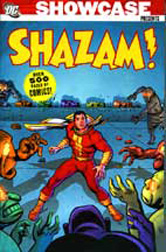 Showcase Presents Shazam Volume 1
Showcase Presents Shazam Volume 1
In the 1940’s Captain Marvel was the highest selling comic in America. The
title was not owned by DC and eventually Superman sued the Captain claiming one
was just too much like the other. One only has to read the books to know this
isn’t true. Superman can be enjoyed at any age, and was, but Captain Marvel is
clearly aimed at the younger set. This is not to say that the stories are not
enjoyable or that the artwork is poorly done. Quite the contrary. However the
stories were written with a level of naivete best received by children. This is
understandable as the hero is a child; Billy Batson, a newsboy, who becomes
Captain Marvel through the use of a magic word.
At some point DC acquired
the rights to the Captain and to avoid complications with Marvel’s use of the
character name brought him back under the title Shazam. The volume under review
collects the first 33 issues of that latter comic. The original artist C.C.
Beck returns here for the first 10 issues and he has lost none of his abilities
over the years. Clearly reminiscent of the ligne claire style from
Europe, his eye or hand is unaffectedly his absence from Captain Marvel.
The stories are as light hearted as ever and as fun to read.
Yet these are still best suited for kids. For adults, the best Captain Marvel
story is the recent 4 issue mini-series Superman Shazam: First Thunder. Get it.
Love it. As for this Showcase volume, buy copies and give one to every child
you know who can read, or is learning to read, or has someone to read the
stories to them, up to the age of 9 or 10. This is the perfect stocking stuffer
to help bring along the next generation of comic book readers.

THREE AND A HALF OUT OF FIVE VIKINGS
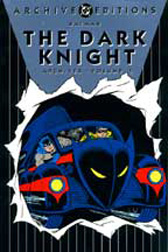 The Dark Knight Archives Volume 5
The Dark Knight Archives Volume 5
DC’s Archives, as well as Marvel’s Golden Age reprints of the same format,
should be deeply welcomed by comic fans. Comics that, even if available, would
be far beyond the pocket of the vast majority of fans, are wonderfully
reprinted in a format that will last in any library for as long as reasonable
care is given them.
This poorly titled edition led off this publication effort by reprinting the
first 4 issues of Batman. Presumably thinking that comic fans familiar with the
Dark Knight/Batman revival would more quickly come to the book bearing this
sobriquet, they have mainly managed to confuse what should be a straight
forward designation. Here we have issue 17 through 20 of the original Batman
issues from the 1940s. While several people are credited with working on the
issues in this volume, the most noteworthy is Dick Sprang whose style defined this
title from 1943 through the early 1960s. Retaining some of the feel of the
earliest issues where Batman was more the grim avenger than the worlds greatest
detective, the stories were yet to sink to the level of caricature that seemed
to dominate in the late 1950s.
This is an excellent book in an excellent series. A gift from those that
hold the keys to the vaults, and available as a gift to anyone you feel has
earned it. This is one to move close to the top of your must have list.

FOUR OUT OF FIVE VIKINGS
Graig Kent:
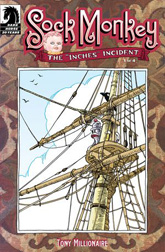 Sock
Sock
Monkey: The Inches Incident #1 & 2 (Dark
Horse Comics)
I’m not sure I ever really “got” Tony
Millionaire’s Sock Monkey. I used to buy
his adventures religiously in the late ‘90’s but never really understood
why. A review I wrote of the second
issue of Sock Monkey at the time, I stated “I bought Sock Monkey #2 for pure
sentimental value (even though I never owned a sock monkey of my own), and I
wasn’t really sure of what I would get.”
Even a couple adventures later I wasn’t sure of what I had gotten. I never really took much from the Sock Monkey
comics, and my recall today, without a refreshing read of those early stories,
is pretty dim.
I closed out that review (from December
1998) stating, “A thoroughly odd and puzzling little comic, Sock Monkey is a
lighthearted adventure aided well by unique and captivating line work.” I guess judging by the Sock Monkey magnet on
my fridge that I really enjoyed the visual aspect of the series, but, again,
the stories havn’t stuck.
The latest Sock Monkey series, The Inches
Incident, finds Uncle Gabby and Mr. Crow stowed away on an old wooden ship
after being tossed into the ocean by their friend Inches (under most mysterious
circumstances). After an encounter with
the ship’s owner and giant sea monsters, Gabby and Crow return home only to
once again be assaulted by Inches. It
turns out inches is possessed in a… grotesque manner and things just get creepy
and twisted from there.
Sock Monkey, eight years later, still
perplexes me, only now I’m not so enthralled with Millionaire’s artwork. The book looks sloppier than I recall, like
it’s a little more rushed, and the story is just plain bizarre. I’m not certain to what audience he’s trying
to appeal to, or if it’s just stream-of-consciousness storytelling in the guise
of a children’s story.

TWO AND A HALF OUT OF FIVE VIKINGS
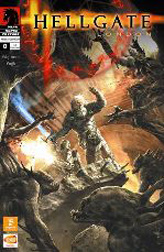 Hellgate: London #0 & 1 (Dark Horse Comics)
Hellgate: London #0 & 1 (Dark Horse Comics)
I don’t play videogames very well, I don’t
have the patience for them. In general
they’ve become too complex to be enjoyable as casual recreation and too
monotonous to be enjoyable as storytelling.
For me, quality gaming ended in the mid-80’s, once more challenging
things could be done with graphics, and computers had more memory to process
more in-game options. That’s not to say
I won’t play the occasional game of Grand Theft Auto or that I havn’t dabbled
for a few months in a MMORPG world, but it is to say that I haven’t got the
perseverance to stick with it.
But I understand. I understand how today’s gaming sucks people
in and holds them for dozens of hours, if not weeks or month’s worth. The graphics are incredible, the storytelling
possibilities are rich, and the passiveness of the play is practically
non-existent. Video games get
professional writers these days to create their stories and to assist with
character design and gameplay, so the worlds of many games are so dense and
high concept that some games can support their own cottage industries of
novels, comics, cartoons, t-shirts, toys, card games etc.
Hellgate: London, I suppose by the amount
of advertising for statues and books and gaming guides found throughout the
first issue, is one of those. The 0
issue delves into the background, what happened when the Hellgate first opened
up in London (for Buffy fans, just think Hellgate = Hellmouth). It showcases how the world changed from
as-you-know it society to, literally, hell on Earth… full scale war between
humans and demons.
Set in 2038, the first issue introduces a
prophecy involving a warrior from each of the three different castes involved
in the resistance battle against the Hellgate and its denizens: the Knights
Templar, the Cabalist and the Demon Hunters.
These three factions havn’t generally gotten along over the years, but
they will reluctantly come together should the need be there, and their three
greatest warriors are gathered for the prophetic mission that could save all.
Written by Ian Edginton, it’s slightly
better than by-the-numbers sword and sorcery (it’s also future tech as well),
and as a derivative of a video game it’s easily enough accessed by
non-players. Steve Pugh, who has always
churned out fantastic artwork, does no less here: great facial expressions,
kinetic action sequences, beautiful women and nasty creatures.
Players of the game will certainly enjoy
this, as it’s above par for what usually passes as derivative work, and I’m
sure it adds greatly to the mythology of the game rather than completely
sidestepping familiar ground. It might
even be interesting enough to convert readers into game players, just not me.

THREE OUT OF FIVE VIKINGS
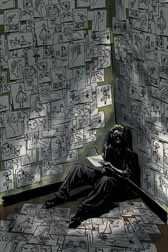 Tag #2 (Boom Studios)
Tag #2 (Boom Studios)
It’s been a few months since the first
issue of Tag appeared, and I normally get pretty jaded when there’s long delays
from one issue to the next. When you
read as many books as I do it’s hard keeping the month-to-month stories
straight, never mind the bi-monthlies or the quarterlies. But the first issue of Tag struck a nerve
with me, and this second issue grabs onto that nerve and just yanks away, so
I’m more than willing to forgive any tardiness in its schedule.
What I like so much about Tag (putting
aside the fact that I’m a huge Keith Giffen fan for a second) is that it’s a
horror book using technology as a major plot device without using it as the
horror. Last issue Mitchell Tanner was
attacked by a mysterious stranger, tagged if you will, after which, suddenly,
he ceased to breath, in fact to live, and yet he still walks and thinks, but
he’s decaying and he has no idea what happened to him. This issue, Mitch is at his ex-girlfriend’s
apartment trying to figure out what happened to him and escape any unwanted
attention from authorities or medical professionals. His first avenue of approach is what most
anyone would do these days, a Google search.
The result is a blog that details not only what happened to Mitch (and
many, many people before him, throughout the centuries), but the rules of the
“game” that Mitch has to play in order to alleviate himself from his condition.
This is the expository issue, but wisely
still leaves more mystery to be uncovered.
Giffen’s concept is ingenious, exciting and slightly terrifying, and,
unlike most modern cyberpunk horror, it gets its chills without using a
ghost-in-the-machine scenario. Kody
Chamberlain’s art is rough and heavily shadowed but this really serves the
story well, yet it’s the grim washes of bleak color from Imaginary Friends
Studio that actually controls the mood of the piece.
Immeasurably great stuff, and a must for
horror fans.

FOUR AND A HALF OUT OF FIVE VIKINGS
Discuss this column on our message boards here.